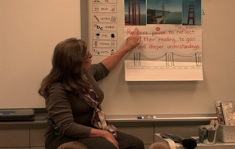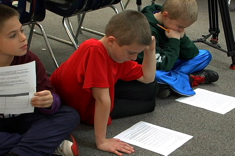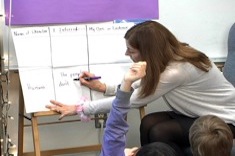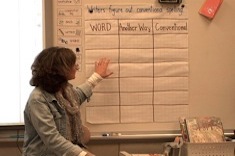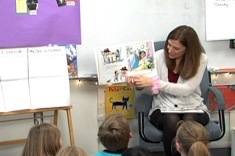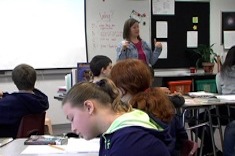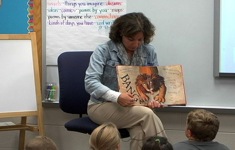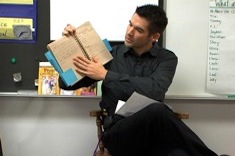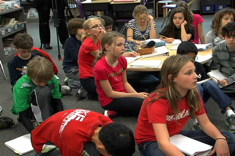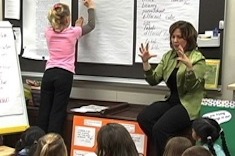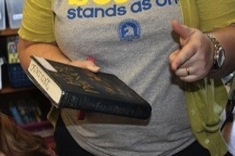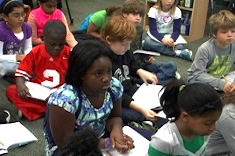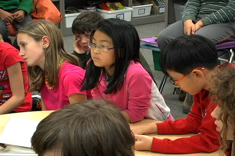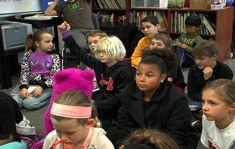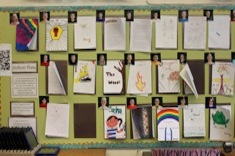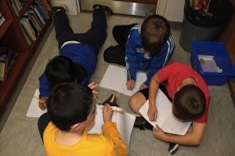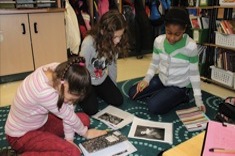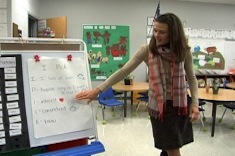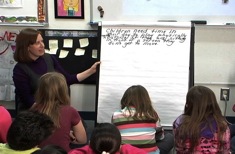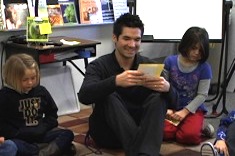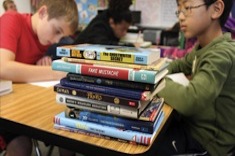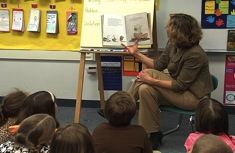Minilessons
Keeping it short, relevant, and meaningful is the challenge when it comes to designing lessons. Here is where you'll find practical advice and dozens of video examples of master teachers in action.
Latest Content
Expanding the Literacy Classroom with Flipped Minilessons
Katharine Hale tries some flipped minilessons in her fifth-grade classroom and explains how technology is providing new opportunities for student learning.
Word Observations
Max Brand describes how word observations can work as powerful minilessons in elementary classrooms.
Bridge to Comprehension Minilesson
Deb Gaby uses a bridge metaphor in a comprehension minilesson for second graders.
“Article of the Week” Activity in Fourth Grade
Tony Keefer finds that the article-of-the-week activity (adapted from Kelly Gallagher's work) is a good way to integrate short shared texts into his fourth-grade literacy workshop.
Rereading and Retelling to Inferring: Part 2
Linda Karamatic uses texts her second graders already know to build their inferring skills as they construct a chart together.
Words Chart Minilesson
Ruth Ayres develops a word chart in this brief minilesson with second graders.
Exploring Inferring with Second Graders: Part 1
Linda Karamatic uses a read aloud to launch a group activity to build understanding of inferring.
Modeling Annotation in 8th Grade
This video from Katie Baydo-Reed’s eighth-grade classroom is the second part of a series on teaching annotation skills in middle school. A catch-up link to the first video in the series is provided.
Second-Grade Minilesson on Capital Letters
Ruth Ayres presents a minilesson on capital letters to a second-grade class.
Finding Topics in Writer’s Notebooks Minilesson
Sean Moore shares the importance of using a writer’s notebook to discover topics in this minilesson with his second-grade students from early in the year.
Thinking About Theme
Karen Terlecky explains how she designs instruction and uses mentor texts to teach theme, and includes a video example of a minilesson.
Two Lessons for Teaching Theme
Franki Sibberson writes about how she chooses books for theme instruction and shares two lessons.
The Art of the Book Talk
If you want to match students to books, you’ll need to master the art of the book talk. Katherine Sokolowski has practical tips for honing your skills.
Whole-Class Research Planning
Andrea Smith leads her fourth graders through brainstorming for their owl research project.
Writing Leads Minilesson
A writing lead is a door — readers will either want to walk through it or shut it and move on to something else. That's the analogy Karen Terlecky uses in this video of a fifth-grade writing workshop minilesson.
Fourth Grade Writing Workshop Minilesson on Focusing
Franki Sibberson shares some tips and strategies with her fourth graders from the web for focusing and organizing their writing.
Launching a Fiction Writing Unit with Fifth Graders
Katherine Sokolowski finds late in the year is the perfect time for launching a fiction writing unit with her fifth graders.
Using Shared Writing to Build Argument Skills
Shari Frost explains the power of shared writing in intermediate classrooms, especially for struggling learners.
Subheading Literacy: Nothing “Sub” About It
Heather Rader discovers subheadings are a neglected but useful tool for teaching students about key topics in their writing.
Keeping Track of Questions
Andie Cunningham observes a third-grade teacher as she systematically improves the quality and depth of student questioning over time.
Shared Reading in the Intermediate Grades
Shari Frost explains why shared reading is valuable for older students, with examples of the practice in the intermediate grades.
10 Principles for Planning Reading Minilessons
Franki Sibberson shares 10 principles for minilesson planning. This is an excerpt from her new book, The Joy of Planning.
Kindergarten I-Pick Minilesson
It’s never too early to help students learn to make wise choices for independent reading. Mandy Robek reviews the I-Pick strategy for choosing appropriate books with her kindergarten students.
Teacher-as-Writing-Model Minilesson in Fourth Grade
Beth Lawson models her process as a writer for her fourth-grade students, describing her emotions as well as creating a draft.
Poetry and Fluency Minilesson in Second Grade
Sean Moore uses the poem “The Busy Ant” for partner work and discussion of fluency and vocabulary with his second graders.
Beyond Text Features in Nonfiction Instruction
Franki Sibberson considers how the demands of the Common Core and the complex mix of online and offline nonfiction texts are changing the skills she teaches students.
Transitions Are Like Underwear
If you tell students transitions are like underwear, they sit up and pay attention. Heather Rader uses the analogy to help students analyze and improve the transitions in their writing.
Touchy Topics for Opinion/Argumentative Writing
When students take a stand in writing, they will almost inevitably bring up touchy topics. Heather Rader considers the challenge in part 3 of her opinion/argumentative writing series.
A Graphic Novels Unit in 5th Grade
Katherine Sokolowski designs a graphic novels unit for her fifth graders, and is surprised by how much the genre delights them.
Previewing and Picture Walks with Fiction Texts
Clare Landrigan and Tammy Mulligan provide previewing how-to advice for grades K-2 teachers.
Browse Content By
Type
Category
- Assessment Tools
- Big Fresh Archives
- Booklists
- Choice Numeracy
- Classroom Design
- Common Core
- Community Building
- Conferring
- Content Literacy
- Digital Literacy
- English Language Learners
- Equity
- Family Relations
- Free Samples
- Guiding Groups
- Leadership
- Literacy Coaches
- Mentor Texts
- Minilessons
- New Teacher Mentors
- Podcasts
- Poetry
- Quote Collections
- Reading Strategies
- Self Care
- Struggling and Striving Learners
- Talking and Listening
- Teacher Study Groups
- Teaching Reading
- Teaching Writing
- Word Study and Vocabulary
Author
- Melissa Quimby
- Nawal Qarooni
- Gwen Blumberg
- Julie Cox
- The Lead Learners
- Hannah Tills
- Josie Stewart
- Ruth Metcalfe
- Mallory Messenger
- Becca Burk
- Jodie Bailey
- Vivian Chen
- Mary Brower
- Tiffany Abbott Fuller
- Stephanie Affinito
- Ruth Ayres
- Leigh Anne Eck
- Heather Fisher
- Shari Frost
- Julie Johnson
- Suzy Kaback
- Gigi McAllister
- Shirl McPhillips
- Melanie Meehan
- Cathy Mere
- Debbie Miller
- Tara Barnett and Kate Mills
- Tammy Mulligan
- Dana Murphy
- Bitsy Parks
- David Pittman
- Brenda Power
- Heather Rader
- Matt Renwick
- Mandy Robek
- Christy Rush-Levine
- Gretchen Schroeder
- Jen Schwanke
- Brian Sepe
- Katherine Sokolowski
- Stella Villalba
- Jennifer Vincent
Grade Level
Choice Literacy Membership
Articles
Get full access to all Choice Literacy article content
Videos
Get full access to all Choice Literacy video content
Courses
Access Choice Literacy course curriculum and training



